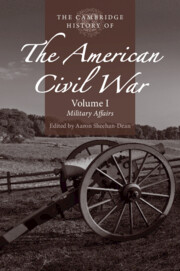Book contents
- The Cambridge History of the American Civil War
- The Cambridge History of the American Civil War
- The Cambridge History of the American Civil War
- Copyright page
- Contents
- Maps
- Contributors to Volume I
- Acknowledgments
- Note on the Text
- 1 Introduction: The Cambridge History of the American Civil War
- Part I Major Battles and Campaigns
- Part II Places
- 20 War on the Rivers
- 21 War on the Waters
- 22 The Blockade
- 23 The Border War
- 24 War in the Deep South
- 25 War in Appalachia
- 26 War in Arkansas, Louisiana, and Texas
- 27 War in the West
- 28 War in Indian Country
- Index
- References
28 - War in Indian Country
from Part II - Places
Published online by Cambridge University Press: 11 October 2019
- The Cambridge History of the American Civil War
- The Cambridge History of the American Civil War
- The Cambridge History of the American Civil War
- Copyright page
- Contents
- Maps
- Contributors to Volume I
- Acknowledgments
- Note on the Text
- 1 Introduction: The Cambridge History of the American Civil War
- Part I Major Battles and Campaigns
- Part II Places
- 20 War on the Rivers
- 21 War on the Waters
- 22 The Blockade
- 23 The Border War
- 24 War in the Deep South
- 25 War in Appalachia
- 26 War in Arkansas, Louisiana, and Texas
- 27 War in the West
- 28 War in Indian Country
- Index
- References
Summary
Stand Watie outlasted them all. By the time the Cherokee chief and Confederate general finally laid down his arms on June 23, 1865, every other remnant of the rebellion had formally capitulated. Robert E. Lee surrendered the main Confederate army at Appomattox, Virginia in early April, while Joseph E. Johnston followed suit later that month at Bennet Place, North Carolina. Even Jefferson Davis, taking flight as president of a now nonexistent government, was finally captured by Union authorities in early May. By keeping his forces in the field for another month and a half, Watie had effectively become the very last Confederate general. Yet the story of Watie’s prolonged resistance belies a much more complicated history of Native American involvement in the Civil War. His Cherokee, Seminole, and Muscogee soldiers may have cleaved to the Confederacy until the very last days of the rebellion, but they were largely unrepresentative of the Indian experience during the war. Relatively few Native Americans professed an ideological commitment to either the Union or the Confederacy. The collective experience from centuries of dispossession at the hands of the federal government and individual settlers had imbued in Indian peoples a well-placed distrust of white Americans. If these Anglo-Americans were to destroy one another in a fratricidal bloodletting, let them do so – this was the grand strategy for much of Native America.
- Type
- Chapter
- Information
- The Cambridge History of the American Civil War , pp. 576 - 600Publisher: Cambridge University PressPrint publication year: 2019



